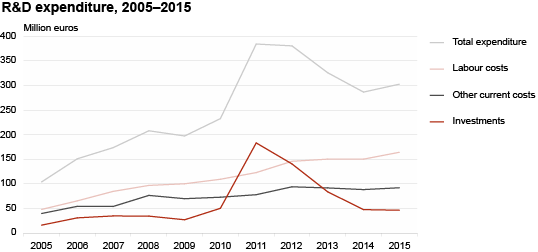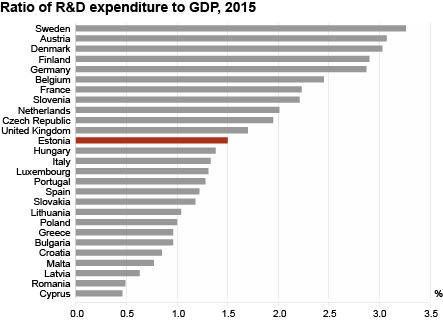Expenditure on research and development increased last year
Expenditure on research and development in the period 2011–2015 experienced an escalation and decline trend. Changes were caused by one-time, large-scale investments in 2010–2012, followed by a decline in the next two years due to the absence of major new investments. It is characteristic of the economy of a small country that one-time investments, especially if these are not followed by equivalent investments in subsequent years, can significantly impact statistical indicators.
46% of R&D expenditure came from the 2015 State Budget. The government funds a substantial share of R&D spending, and this remained stable in 2013–2015. The share of R&D financing in the total general government expenditure was 1.7%. It is important to note that the funding allocated to R&D by the government also includes the European Union's subsidies, which are included in the State Budget and are counted as government allocations.
The ratio of R&D expenditure to gross domestic product (GDP) was 1.5%, remaining on last year’s level. According to Eurostat’s preliminary data, with its R&D intensity indicator Estonia retained its intermediate position among the EU Member States.
Research and development expenditure in the business enterprise sector was 139.4 million euros, which accounted for 46% of the total R&D expenditure. Spending increased by 11% compared to the previous year, and this is mainly due to increased labour costs. The share of investments in the R&D expenditure of the business enterprise sector was at a record low, amounting to only 17% of the total expenditure, which is the lowest in the last five years. Obviously, this is influenced by the overall economic situation where investment activity started to decline already in 2013, and this downward trend continued in 2015.
The R&D expenditure in the non-profit sector (higher education, government and non-profit private sector) was 163.4 million euros, i.e. 54% of total R&D costs. Of these, 79% were funded by the government. The biggest share – 41% of the non-profit institutional sector’s R&D expenditure – was in the higher education sector. Similarly to the business enterprise sector, in the non-profit institutional sector, labour costs accounted for the greatest share of research and development expenditure – 50%.
The number of research and development employees calculated in full-time equivalents declined 6% compared to 2014. Calculated in full-time equivalents, the number of researchers and engineers declined slightly less – by 3%. The decrease in the number of full-time researchers and engineers was influenced the most by the business enterprise sector, where the figure fell by 9% compared to 2014; in the non-profit sector the decline was only 1%. However, labour costs in research and development grew by a total of 9%, including in the business enterprise sector by 18% and in non-profit sectors by 1%.
For the statistical activity “Research and development”, the main representative of public interest is the Ministry of Education and Research, commissioned by whom Statistics Estonia collects and analyses the data necessary for performing this statistical activity.
